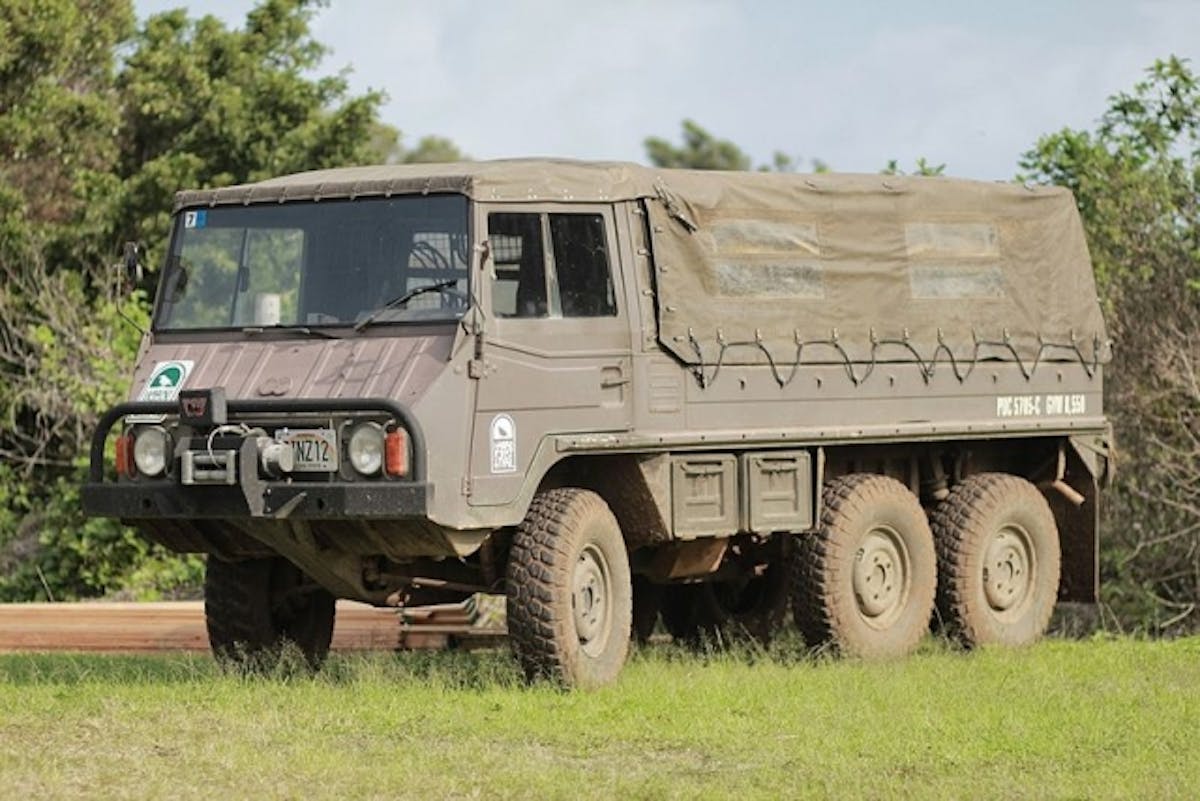
For decades, different military branches have contributed greatly to the off-road industry, from production of the early Willys Jeeps in WWII all the way up to modern-day Humvees still used around the world today. But not all of our beloved classic off-road vehicles originated with United States military use. In fact, one of the most beloved today, the Pinzgauer and all its sub-models actually came from overseas. Let’s take a look at that rather unique vehicle in this week’s Vintage Monday.

Though originally designed in the late 1960s, the Pinzgauer, produced by Austrian-based Steyr-Daimler-Puch, wasn’t put into production until 1971. Built as a successor to the Haflinger 700 AP 4×4 military vehicle, the Pinzgauer (named after a horse breed), was produced specifically as a light multipurpose off-road vehicle.
Produced as a high-occupancy all-terrain military vehicle, the Pinzgauer was available in both 4×4 and 6×6 models, both with 86.6-inch wheelbases.
The more popular of the two, the 710 Pinzgauer model, which was set atop a 4×4 chassis, was available in five different configurations, including a flatbed carrier, soft-top model with up to eight rear passenger seats, a five-door hardtop station wagon and an ambulance, available in two varieties: a three-door version or one with a removable, air-portable shelter on the back.
 The bigger 712 model, which sat atop a 6×6 chassis, was also available as a flatbed carrier, soft-top with rear passenger seats, five-door station wagon and ambulance with a removable, air-portable shelter. Additionally, 712 models could be had as a four-door crew cab pickup, firetruck or a mobile workshop with an air-portable shelter. Obviously, all of these available variants helped the Pinzgauer live up to its highly versatile purpose.
The bigger 712 model, which sat atop a 6×6 chassis, was also available as a flatbed carrier, soft-top with rear passenger seats, five-door station wagon and ambulance with a removable, air-portable shelter. Additionally, 712 models could be had as a four-door crew cab pickup, firetruck or a mobile workshop with an air-portable shelter. Obviously, all of these available variants helped the Pinzgauer live up to its highly versatile purpose.
 Giving the Pinzgauer even more versatility was its central “backbone” tube chassis equipped with a transaxle, integrated differentials with on-the-fly hydraulic differential locks, and portal axles for extra clearance.
Giving the Pinzgauer even more versatility was its central “backbone” tube chassis equipped with a transaxle, integrated differentials with on-the-fly hydraulic differential locks, and portal axles for extra clearance.
A fully independent suspension system helped keep both four-wheel-drive and six-wheel-drive Pinzgauer varieties on all four corners while vacuum-assisted drum brakes gave the off-road vehicle plenty of stopping power.
The 710 models were equipped with coil springs all the way around, while the 712 models were fitted with leaf springs in the rear for added weight-bearing capabilities.
Payload ratings for the Pinzgauer models were substantial with the 4,300lb 710 models having a payload rating of 2,200lbs and the 5,300lb 712 models with a payload rating of just over 3,300lbs.
 Powering the majority of Pinzgauer models was an air-cooled all-alloy 2.5L inline-4 engine good for just 90 bhp with cast iron cylinder liners, while an air-cooled 2.7L four-cylinder engine was available (late in the first generation) on some 712 models, particularly the ambulance. The 2.5L engine was equipped with two Zenith dual carburetors and two different oil pumps, which allowed the engine to still operate at various angles, and was made to run on low-octane fuel.
Powering the majority of Pinzgauer models was an air-cooled all-alloy 2.5L inline-4 engine good for just 90 bhp with cast iron cylinder liners, while an air-cooled 2.7L four-cylinder engine was available (late in the first generation) on some 712 models, particularly the ambulance. The 2.5L engine was equipped with two Zenith dual carburetors and two different oil pumps, which allowed the engine to still operate at various angles, and was made to run on low-octane fuel.
The engine was backed by a five-speed manual transmission with a two-speed transfer case. The system is powered by a completely water-proof 24-volt electric system.
Though mostly marketed as a military vehicle, the Pinzgauer was also available for civilian use, with just over 18,000 units produced for the combined military/civilian first-generation.
The first-generation of 710 and 712 models were produced from 1971 through 1979. In 1980, the Pinzgauer transitioned into its second generation, which brought with it a number of changes over the years, unlike in the first generation. Some of these changes included the introduction of a four-speed automatic transmission as standard equipment, disc brakes, larger tires, and of course, the introduction of the Volkswagen-built inline-6 turbocharged direct injection diesel engine. Starting in 1980, the 4×4 Pinzgauer models were marketed as 716s and the 6×6 models as 718s. The second-generation Pinzgauers were produced through 2007.
 Pinzgauer models that are or have been imported into the United States are mostly from the first-generation due to high costs and stringent certification criteria of second-generation models, though second-generation variants can be found occasionally. A true favorite of off-road enthusiasts, Pinzgauer models can currently be purchased through private sellers and even companies specializing in the model’s sale.
Pinzgauer models that are or have been imported into the United States are mostly from the first-generation due to high costs and stringent certification criteria of second-generation models, though second-generation variants can be found occasionally. A true favorite of off-road enthusiasts, Pinzgauer models can currently be purchased through private sellers and even companies specializing in the model’s sale.
You might also like
From 2WD to 4WD: This Father-Daughter 1970 Dodge D200 Build Is Fire
This awesome big-block 1970 Dodge D200 is June Emily's first truck. It's a father-daughter project that began as a 2WD truck.


